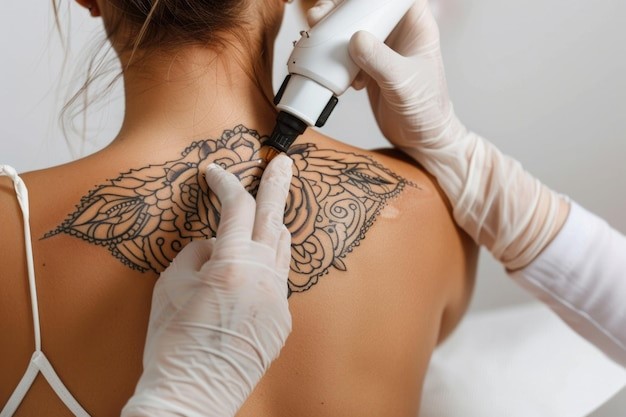
Tattoo removal is a medical procedure aimed at eliminating unwanted tattoos from the skin. This process involves breaking down the ink particles embedded in the skin so that the body can naturally eliminate them. There are several methods available for tattoo removal, each with its own set of advantages and considerations. The most common and effective technique is laser tattoo removal, but other methods include surgical excision, dermabrasion, and chemical peels.
- How It Works: Laser tattoo removal uses high-intensity light beams to break down the ink particles in the skin. Different wavelengths of laser light are used to target various ink colors.
- Procedure: During a session, a laser device emits pulses of light that penetrate the skin and fragment the ink. The body’s immune system then gradually removes these broken-down particles.
- Sessions Required: Multiple sessions (typically 5-10) are needed, spaced several weeks apart.
- Pros: Highly effective, minimal scarring, and suitable for most skin types and ink colors.
- How It Works: Laser tattoo removal uses high-intensity light beams to break down the ink particles in the skin. Different wavelengths of laser light are used to target various ink colors.
- Procedure: During a session, a laser device emits pulses of light that penetrate the skin and fragment the ink. The body’s immune system then gradually removes these broken-down particles.
- Sessions Required: Multiple sessions (typically 5-10) are needed, spaced several weeks apart.
- Pros: Highly effective, minimal scarring, and suitable for most skin types and ink colors.
- How It Works: Dermabrasion uses a high-speed rotary device to sand off the top layers of the skin, allowing new skin to grow over the area.
- Procedure: Under local anesthesia, the skin is abraded to remove layers containing the tattoo ink.
- Sessions Required: Multiple sessions may be needed depending on the tattoo’s size and depth.
- Pros: Can be effective for superficial tattoos.


- How It Works: Chemical peels involve applying acid solutions to remove the outer layers of the skin that contain the tattoo ink.
- Procedure: An acid solution is applied to the tattooed area, causing the skin to blister and peel off over time.
- Sessions Required: Multiple treatments are often needed.
- Pros: Less invasive than surgery.
- Tattoo Age: Older tattoos are often easier to remove as the ink has had time to break down naturally.
- Ink Colors: Some colors, like black and dark blue, are easier to remove than others, such as green, red, and yellow.
- Tattoo Size:Larger tattoos require more sessions and can be more challenging to remove completely.
- Skin Type: Individual skin type and overall health can impact the removal process and outcomes.
- Consultation: A thorough consultation with a plastic surgeon or trained professional to assess your tattoo and discuss the best removal method for you.
- Pain Management: Techniques such as numbing creams, local anesthesia, or cooling devices may be used to minimize discomfort during the procedure.
- Post-Treatment Care: Proper aftercare is crucial, including keeping the area clean and moisturized, avoiding sun exposure, and following specific instructions from your practitioner.
- Healing Time: Healing times vary depending on the removal method and individual skin type, with laser removal typically requiring several weeks of healing between sessions.
Tattoo removal is a viable option for those looking to erase unwanted ink and start fresh. With advancements in technology, the process has become more effective and accessible. Understanding the various methods and setting realistic expectations are key to achieving the best results. Always consult with a professional to determine the most suitable method for your specific needs and skin type.


- Choose a Reputable Professional: Ensure your procedure is performed by a qualified and experienced practitioner.
- Follow Aftercare Instructions: Proper aftercare can significantly impact the results and reduce the risk of complications.
- Be Patient: Tattoo removal is a process that takes time, often requiring multiple sessions.
- Consider Your Skin Type: Discuss with your practitioner how your skin type may affect the removal process and outcomes.
- Tattoo Age: Older tattoos are often easier to remove as the ink has had more time to break down naturally.
- Ink Colors: Some colors are more difficult to remove than others. Black and dark blue inks are usually the easiest, while greens, reds, and yellows can be more challenging.
- Tattoo Size: Larger tattoos require more sessions and can be more difficult to remove completely.
- Skin Type: The individual’s skin type and overall health can affect the removal process and outcomes.
